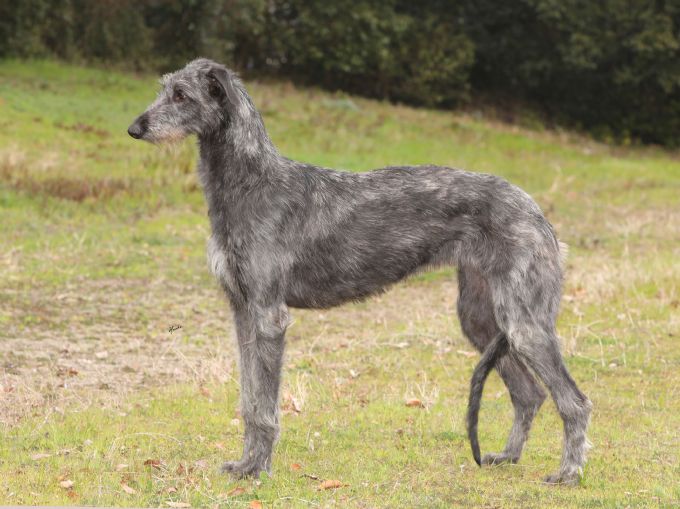The Deerhound Standard

In the last half of nineteenth century, the new ‘sport’ of dog exhibiting became popular and resulted in the development of formal descriptions for the various breeds of dog, which helped stabilise and ensure purity, whilst creating a blueprint to judge dogs against. This blueprint is called a standard, and each breed has its own, detailing the origin and heritage of the breed and describing its structure and traits, its ideal characteristics, temperament, and appearance, and ensures that the breed is fit for function.
The Deerhound Standard, presented to the Deerhound Club in 1892 and endorsed by the Club in 1901, has remained practically the same since its adoption. There has been, however, a few modifications to the height criteria and the ‘scale of points’. The change to height criteria has been a contentious issue even today, but it is futile argument and serves no purpose as the changes occurred over 100 years ago and modern enthusiasts should adhere to the Standard as it appears today.
It must be remembered that if not for the Standard and conformation showing, the magnificent Deerhound we have today would likely have disappeared.
The purpose for which the Deerhound evolved, hunting red deer, is no longer permitted in many countries and jurisdictions, and that has fuelled debate about the ability of modern Deerhounds to perform the work for which they were bred. While some insist that conformation showing has caused selection and breeding of dogs on their appearance alone, and that has reduced the working ability of Deerhounds, there is no proof that this has occurred to any great degree. Any owner of a Deerhound will attest to its hunting drive and desire to chase, and to its athleticism and speed. In Australia at least, Deerhounds are only a few generations away from common use in the field and the purpose for which they were bred for centuries.
There is always a risk that some exhibitors and some breeders may select their stock on exaggerated features to chase show ring success, but in general Deerhound breeders, exhibitors, judges, and fanciers have resisted fads, and the Deerhounds of today remain virtually unchanged when compared to those on which the Standard was based, over 130 years ago.
Reputable breeders view the Standard as a whole and place a lot of emphasis on structure and movement. Form, function, and fitness for purpose are key elements in the Standard and are the backbone of any breeding programme.
Deerhound breeders can assess their dogs at running sports such as lure coursing and open field running.
The following is a noteworthy quote from the renowned Ballincrea Kennels. “My kennel’s motto is ‘True To Tradition’ which does not necessarily encompass deer hunting but does adhere to breeding dogs fit for that purpose”. Interview with Paul Wilson - by Virginia Hawke. DEERHOUND magazine November 2020.
The best way for a kennel to display its stock is on the show benches, at major and specialist shows, where dogs can be assessed and compared against their contemporaries, and where other breeders can see the dogs in real life, and even run their hands over them. While a win in the ring adds some prestige, breeders often put more store in the opinions of other breeders and enthusiasts, who have in mind criteria and interpretations of the Standard that may differ to that of the Show Judge on the day. Attending major shows gives breeders the opportunity to view and consider the potential use of other bloodlines in their breeding programme.
There are a number of canine controlling bodies that oversee the Deerhound Standard.
The country of origin is the recognised owner of the Deerhound Standard and as such ownership lies with
THE KENNEL CLUB (UK) and THE DEERHOUND CLUB (UK).
In 2009, breed standards were reviewed and most of the standards, including that of the Deerhound, required little or no change.
Dogs Australia (ANKC) shares an agreement with The Kennel Club.
FEDERATION CYNOLOGIQUE INTERNATIONALE (FCI) - The World Canine Organisation has 98 members and contract partners.
Dogs Australia (ANKC) shares an agreement with the FCI and is an Associate Member.
FCI Standard No: 164 Deerhound, is drawn from the Standard adopted by The Kennel Club (UK) as amended 2009.
In Australia the Deerhound Standard is the same as the
The Kennel Club and FCI Standard https://ankc.org.au/Breed/Detail/135
The AUSTRALIAN NATIONAL KENNEL COUNCIL (ANKC), also known as Dogs Australia, in conjunction with the DEERHOUND CLUB of VICTORIA produced the
‘Extended Breed Standard of THE DEERHOUND’ (adopted by the ANKC in 2009).
https://ankc.org.au/media/pdf/635576269663439806_2aafa18a-d964-4bc2-8054-e130e4d97281.pdf
The ANKC also recognises the AMERICAN KENNEL CLUB (AKC).
The Deerhound Standard used in the USA by the American Kennel Club (AKC), is the
Scottish Deerhound Breed Standard (approved March 1935).
Many of the images and some of the text used in writing the ANKC ‘Extended Breed Standard of THE DEERHOUND’ were sourced (with approval) from the
SCOTTISH DEERHOUND CLUB of AMERICA and the AKC.
